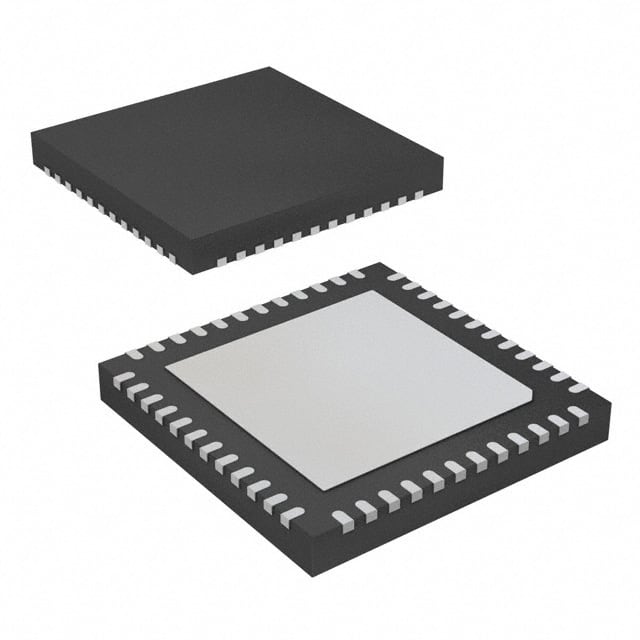Lihat spesifikasi untuk detail produk.

PIC24F16KM104-I/MV
Basic Information Overview
- Category: Microcontroller
- Use: Embedded systems, control applications
- Characteristics:
- High-performance 16-bit microcontroller
- Low power consumption
- Large memory capacity
- Rich peripheral integration
- Package: 44-pin QFN package
- Essence: Advanced microcontroller for various control applications
- Packaging/Quantity: Available in reels of 2500 units
Specifications
- Architecture: 16-bit
- CPU Speed: Up to 16 MIPS
- Program Memory Size: 16 KB
- RAM Size: 1 KB
- Data EEPROM Size: 256 bytes
- Operating Voltage Range: 2.0V to 3.6V
- Temperature Range: -40°C to +85°C
- Number of I/O Pins: 36
- Analog-to-Digital Converter (ADC): 10-bit, up to 16 channels
- Communication Interfaces: UART, SPI, I2C
- Timers: Multiple timers with various modes
- PWM Channels: Up to 5 channels
- Interrupt Sources: Multiple sources with prioritization
Detailed Pin Configuration
The PIC24F16KM104-I/MV microcontroller has a total of 44 pins. The pin configuration is as follows:
- Pins 1-8: General-purpose I/O pins
- Pins 9-12: Analog input pins
- Pins 13-20: General-purpose I/O pins
- Pins 21-28: General-purpose I/O pins
- Pins 29-32: Communication interface pins (UART, SPI, I2C)
- Pins 33-38: General-purpose I/O pins
- Pins 39-42: Timer and PWM output pins
- Pins 43-44: Power supply and ground pins
Functional Features
- High-performance 16-bit CPU for efficient processing
- Low power consumption for extended battery life
- Ample memory capacity for storing program code and data
- Integrated peripherals such as ADC, UART, SPI, and I2C for versatile communication
- Multiple timers and PWM channels for precise timing and control
- Flexible interrupt system for handling various events
Advantages and Disadvantages
Advantages: - High-performance architecture enables fast execution of instructions - Low power consumption extends battery life in portable applications - Rich peripheral integration reduces external component count - Ample memory capacity allows for complex control algorithms
Disadvantages: - Limited number of I/O pins may restrict the number of connected devices - Higher cost compared to lower-end microcontrollers with fewer features - Steeper learning curve due to the complexity of the device
Working Principles
The PIC24F16KM104-I/MV microcontroller operates based on the Harvard architecture, where separate program and data memories are used. It executes instructions stored in the program memory and manipulates data stored in the data memory. The CPU fetches instructions from the program memory, decodes them, and performs the necessary operations.
The microcontroller interacts with the external world through its I/O pins, which can be configured as inputs or outputs. It communicates with other devices using various communication interfaces like UART, SPI, and I2C. The integrated ADC allows for analog signal conversion, enabling the microcontroller to interface with sensors and other analog devices.
Detailed Application Field Plans
The PIC24F16KM104-I/MV microcontroller finds applications in various fields, including but not limited to: - Industrial automation - Home automation - Automotive systems - Medical devices - Consumer electronics
In industrial automation, it can be used for controlling machinery, monitoring sensors, and managing communication protocols. In home automation, it can enable smart home functionalities such as lighting control, temperature regulation, and security systems. In automotive systems, it can be utilized for engine management, dashboard control, and safety features. In medical devices, it can facilitate patient monitoring, diagnostics, and drug delivery systems. In consumer electronics, it can power devices like smart appliances, wearable devices, and gaming peripherals.
Detailed and Complete Alternative Models
- PIC24F08KM101-I/MV: Similar microcontroller with reduced memory capacity and fewer I/O pins.
- PIC24F32KA304-I/ML: Microcontroller with higher memory capacity and additional features like USB connectivity.
- PIC24FJ64GA004-I/PT: Microcontroller with larger program memory and enhanced analog capabilities.
- PIC24F16KA102-I/SO: Microcontroller with lower power consumption and smaller package size.
These alternative models offer different combinations of features and specifications to cater to specific application requirements.
Sebutkan 10 pertanyaan dan jawaban umum terkait penerapan PIC24F16KM104-I/MV dalam solusi teknis
What is the maximum operating frequency of PIC24F16KM104-I/MV?
- The maximum operating frequency of PIC24F16KM104-I/MV is 32 MHz.Can PIC24F16KM104-I/MV be used in battery-powered applications?
- Yes, PIC24F16KM104-I/MV is suitable for battery-powered applications due to its low power consumption.What are the communication interfaces supported by PIC24F16KM104-I/MV?
- PIC24F16KM104-I/MV supports SPI, I2C, and UART communication interfaces.Is PIC24F16KM104-I/MV compatible with 5V systems?
- No, PIC24F16KM104-I/MV operates at 3.3V and is not directly compatible with 5V systems.What development tools are available for programming PIC24F16KM104-I/MV?
- Development tools such as MPLAB X IDE and MPLAB XC16 Compiler can be used to program PIC24F16KM104-I/MV.Does PIC24F16KM104-I/MV have built-in analog-to-digital converters (ADC)?
- Yes, PIC24F16KM104-I/MV features integrated 10-bit ADC modules.Can PIC24F16KM104-I/MV be used in industrial control applications?
- Yes, PIC24F16KM104-I/MV is suitable for industrial control applications due to its robust features and peripherals.What is the temperature range for operating PIC24F16KM104-I/MV?
- PIC24F16KM104-I/MV has an operating temperature range of -40°C to 125°C.Are there any application notes or reference designs available for PIC24F16KM104-I/MV?
- Yes, Microchip provides application notes and reference designs to assist in implementing PIC24F16KM104-I/MV in various technical solutions.Can PIC24F16KM104-I/MV be used in motor control applications?
- Yes, PIC24F16KM104-I/MV is suitable for motor control applications with its advanced PWM and timer modules.

